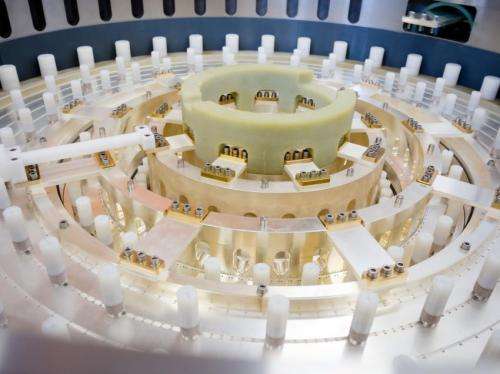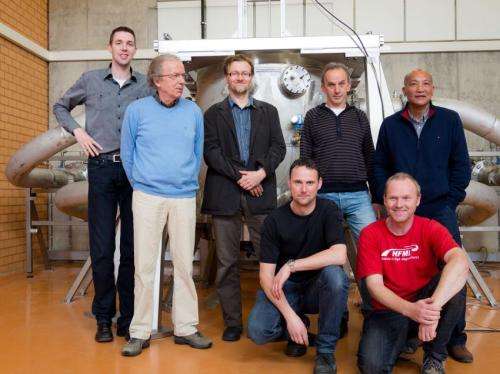HFML sets world record with a new 38 tesla magnet

The High Field Magnet Laboratory (HFML) at the Radboud University Nijmegen set a new world record today: the generation of a continuous magnetic field of 38 tesla in a resistive (i.e. non-superconducting) magnet. Strong magnetic fields of this type are crucial for materials research. The HFML's design proves that expensive superconducting coils are not needed to achieve 38 tesla, which lowers the purchasing costs by a factor of ten. The new magnet will be officially commissioned on 10 April.
Materials research creates an ongoing demand for stronger magnets, as higher magnetic fields allow more properties of important materials to be uncovered and investigated. In a magnetic field of 38 tesla, certain quantum effects are one hundred times stronger than in a field of 33 tesla, which, until now, was the maximum magnetic field available in the Radboud University lab. This is why, in 2011, the HFML began the very ambitious project to design a resistive magnet which would surpass the current world record of 36 tesla.
A leap for science
According to HFML researcher Dr. Uli Zeitler, the 38 tesla field is a big leap for science: "The step from 33 tesla to 38 tesla is very significant for us. We will be able to clarify the properties of materials faster and more efficiently, and this will provide a major boost to materials innovation and development. This is of interest to us at the HFML, as well as to external researchers who come to use our facilities. Experiments in such high magnetic fields are currently only possible in the 45 tesla hybrid magnet, a partially superconducting magnet in Tallahassee (USA), which is hugely overbooked and cannot satisfy all the demand. With our new 38 tesla magnet, we will make magnetic fields of this level available to a larger group of scientists."
Cooling holes
Dr. Frans Wijnen was project manager of the project that pushes the boundaries of technology. One of the challenges he faced was to optimise the cooling of the magnet coils. To produce a stronger magnetic field, a higher current must pass through the coils and this generates more heat. Wijnen: "Each of the coils has many small holes in it, through which a cooling fluid passes, and better cooling can be achieved by increasing the size of these cooling holes. However, this results in more current passing through the remaining sections of the coil, which increases the force experienced by these sections. We calculated that we could only increase the size of the holes sufficiently if we changed the shape of the holes and, thus, the location of the stress points: a fundamentally different design. Fortunately, this modification proved successful."
HFML Director Prof.dr. Nigel Hussey: "Pioneering science often requires pioneering technologies. Here at the HFML, the team have done a fantastic job in successfully creating this unique environment for scientific research. With a second 38 tesla magnet planned for 2015, we are looking forward to a large influx of new users to the laboratory from around the world in the coming years."

Large scale and precise
With this new design, HFML also challenged a number of Dutch suppliers and manufacturers. For example, the coils had to be made of another material. Wijnen: "Many of the HFML magnet coils are made of copper, which is not strong enough for this new magnet. That is why we switched to a compound of copper and silver. Brandsma Metaalveredeling (Brandsma metal processing) managed to silver-plate this complex material and MCi punched the cooling holes. These are large devices, but with an unprecedented precision. The pinnacle was the external casing for the magnet, on which we collaborated with Van Halteren. The casing weighs several tonnes, with the lid alone weighing over a tonne."
Bargain
The cost of the new HFML magnet was less than a tenth of that of the hybrid magnet in Tallahassee. Wijnen: "Hybrid magnets are made up of a resistive inner coil and a superconducting outer coil. They cost around 15 million euros. Our 38 tesla magnet costs 1.5 million euros, and we are currently planning to construct a second one for only 1 million euro. That is a different order of magnitude, even when you take the electricity costs of about one million euros per year into account." Nevertheless, HFML is currently building a hybrid magnet as well. "There is a limit to resistive magnets, and with this breakthrough, we are now nearing that limit. Our own hybrid magnet, which should be ready in 2017, is expected to achieve 45 tesla."
The HFML is a collaboration between Radboud University Nijmegen and FOM, the Foundation for Fundamental Research on Matter. The lab is part of the European Magnetic Field Laboratory (EMFL). Researchers will be able to request magnet time on the new 38 tesla magnet from 15 April via the EMFL website.
More information: HFML website
Provided by Fundamental Research on Matter (FOM)


















